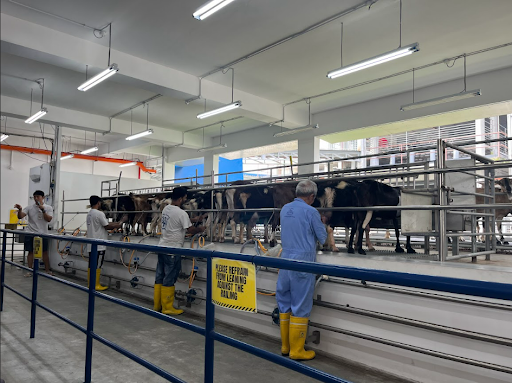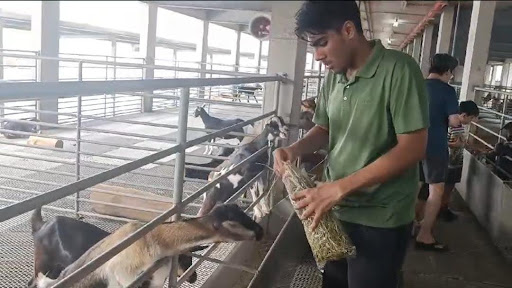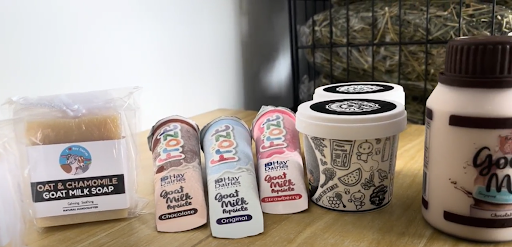Join The UrbanWire as we revisit Hay Dairies to explore what they have to offer for those looking to spend quality time with their kith and kin! But before we dive in, let us rewind 35 years before Hay Dairies evolved into what it is today, and find out how it all started!
Overcoming Adversity
Mr. Hay Yak Tang came to Singapore in 1920 at age 16 as a teacher. Lacking passion for teaching, he shifted careers, first working as a clerk for a hatchery and eventually owning one. He later acquired a 16-acre plantation in Punggol, establishing Yak Seng Hay farm to rear ducks, chickens, and pigs.
In the ’70s, Mr. Hay ventured into pig farming, importing breeds from America. As his business developed, he enlisted eight of his eleven sons who helped Hay build one of Singapore’s biggest pork suppliers (at the time) with 20,000 pigs. When pig farming was phased out in the early ’80s, Mr. Hay transitioned to goat farming with the help of the Singapore Food Agency. After contacting American breeders, he and his family began Hay Dairies with Alpine, Nubian, Saanen, and Toggenburg goats in 1988.
Today, Hay Dairies is Singapore’s only goat farm, home to over 800 mixed-breed goats from Minnesota, USA.
Now that you’re up to speed on the farm’s history, here’s a detailed breakdown of what went down during our visit:
#1 Milking Session
Our first stop during the tour was the milking session, which takes place from 9.00 am to 10.30 am except on Tuesdays (when Hay Dairies is closed). Since we were part of the Free & Easy tour, we didn’t have to pay for anything. But do take note that this tour is only free to the public who come in a group of less than ten people (no reservation required).

Moving on, one thing that caught our attention was that the goats seemed entirely nonchalant during the milking process. They behaved with utmost decorum by voluntarily placing their heads into the stanchions, which shows how disciplined and well-trained these goats are.
The goats at Hay Dairies belong to the family of goats known as Dairy goats, which are domesticated and kept for milk production. As you might suspect, from their small size each goat can only produce a meagre three litres of milk per day. Dairy cows, in comparison, can produce up to 28 litres per day!
The milk produced by the goats will then undergo pasteurisation and be sold to the public as milk, gelatos, popsicles, and even soaps at the Hay Dairies retail store.
Fun fact #1: Did you know that goat milk can even be consumed by people with lactose intolerance or those who are allergic to cow milk? Mind-blowing!
Something else that blew our minds was an opportunity to get in touch with nature & feed the goats in an up-close interaction with them.
#2 Feeding Session
As we were filming at the milking parlour, we heard what we assumed were the bleats of famished goats from the barn next door. So naturally, after filming, we rushed over to feed them some treats. Little did we know that these were bleats not of hunger, but of satisfaction, as upon our arrival there was already a huge crowd of people feeding them Alfalfa hay!
Wanting to feed the goats ourselves, we went ahead and purchased a packet of Alfalfa hay (S$5 per packet for those not on a tour) from the Hay Dairies retail store,.Once we headed back, we fed the goats copious amounts of Alfalfa Hay which we later learned was flown in from the United States. Alfalfa Hay is not only free from Genetic Modification Organisms (GMO), but is also high in protein and minerals.

Fun fact #2: Did you know that the horizontal slits of a goat’s eyes give them 340 degree vision?
No wonder they could sense our presence in the barn when we were at the milking parlour!
By now it had been about two hours since our tour began, and the heat & excitement were starting to take their toll. So, we bravely retreated to the relative serenity of the Hay Dairies Retail Shop to get some snacks.
#3 Retail Shop
As mentioned earlier, the milk produced during the milking process gets made into a wide assortment of food and body products.

- Goat Milk: Original and Chocolate flavors in 800 ml and 200 ml sizes.
- Goat Milk Popsicles: Original, Chocolate, and Strawberry flavours.
- Goat Milk Gelato: Honeycomb and Watermelon flavors.
- Goat Milk Soap: Lavender and Oat & Chamomile scents.
#4 Bah-well
On the whole, we had an eye-opening experience at Hay Dairies Farm. From watching them getting milked to having hands-on experience in feeding them, to drinking their delicious milk at the retail store, it was clear to us that the goats were the centre of attraction, capturing the hearts of the public through their antics.
If you are looking to go on a solo adventure or family trip, then Hay Dairies should definitely be on the top of your list. Relax and unwind in the company of goats and have a blast when visiting Hay Dairies Farm!
PS: Do yourself a favour and get some popsicles!
@theurbanwire Take it from us, fresh goat milk popsicles are the best 😋 Join The UrbanWire as we rewind 35 years and explore the roots of Hay Dairies, Singapore’s only goat farm, and home to over 800 mixed-breed goats! 🐐 #theurbanwire #haydairies #haydairiesgoatfarm #goatfarm #singapore #fypsingapore
♬ original sound – theurbanwire – theurbanwire
